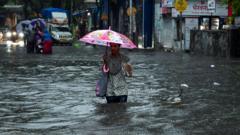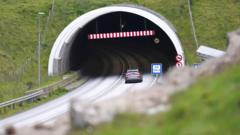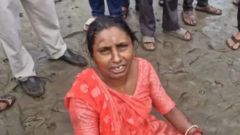The annual monsoon season in India continues to wreak havoc in major cities like Mumbai and Delhi, as heavy rains lead to widespread flooding and infrastructure failure. Experts attribute the chaos to rapid urbanization, outdated systems, and poor planning, calling for a comprehensive approach to prevent future disasters.
India’s Annual Monsoon Crisis: A Wake-Up Call for Urban Planning

India’s Annual Monsoon Crisis: A Wake-Up Call for Urban Planning
Major cities across India are grappling with flooding ahead of the monsoon season, exposing the shortcomings of urban infrastructure and planning.
Heavy monsoon rains have once again wreaked havoc in India's bustling cities, sparking outrage among residents who find themselves stranded and soaked due to inadequate infrastructure. The financial capital of Mumbai was brought to a halt last month before the monsoon season even officially began, with roads transforming into rivers and vehicles easily succumbing to the floodwaters. Even a newly constructed underground metro station was inundated, prompting discussions about the city's vulnerability to severe weather.
The Brihanmumbai Municipal Corporation (BMC), tasked with managing the city’s infrastructure, cited clogged drains and debris from metro construction as contributors to the flooding. In response to public backlash, the BMC deployed de-watering pumps and set about cleaning the drains to mitigate further waterlogging—though many residents feel these efforts arrived too late.
This flooding is not an isolated incident affecting only Mumbai. From Delhi in the north to Bengaluru in the south, major Indian cities encounter similar challenges during the annual monsoon period. Experts highlight rapid, unplanned urbanization, aging infrastructure, and prolonged environmental neglect as underlying causes. Urban planner Dikshu Kukreja emphasizes that existing drainage systems were designed decades ago and cannot cope with the current scale of urban expansion that has overlooked natural water absorption areas.
The significance of the monsoon is undeniable in India—about 80% of the country's annual rainfall falls within a few months, providing much-needed water for agriculture and millions of farmers. However, climate change exacerbates the tumultuous weather patterns, resulting in erratic rainfall and floods cascading across cities that historically would not suffer such extremes.
In Delhi, incidents such as vehicles stuck under the easily flooded Minto Bridge exemplify the routine chaos that unfolds during monsoon season. This year alone, Delhi experienced its wettest May since 1901, resulting in property damage and casualties among residents due to severe storms.
Bengaluru, situated 1,240 miles from Delhi, reflects a different yet shared struggle. Previously known for its extensive lakes and water bodies that regulated rainfall, much of this natural landscape has been replaced by construction, rendering the city defenseless against flooding. Lake conservation activist Ram Prasad highlights how development within designated no-construction zones has compounded the issue, transforming historical flood buffers into vulnerable sites for urban construction.
The geographical challenges facing cities are complex. Mumbai's low-lying coastal regions are even more susceptible to flooding during severe weather. Yet, the problem deepens with human actions—deforestation of protective mangroves and construction on historically flood-prone land amplify the risk.
Experts assert that the current breakdown in urban planning is systemic and requires proactive approaches. Dimitri Kukreja argues that it involves anticipating climatic changes, improving governance, and enforcing regulations. The call for a long-term, coordinated strategy is critical—technological advancements, real-time risk mapping, and community participation must coordinate effectively to build resilience in urban environments.
While larger cities heavily impacted by the monsoon make headlines, smaller towns often suffer catastrophically as well. A recent incident in northeastern India led to significant loss of life due to heavy rains triggering flooding and landslides.
Authorities and citizens alike must recognize that to combat climate-induced challenges, strategic urban planning and infrastructure investments need to be prioritized to protect communities before the next deluge strikes.





















